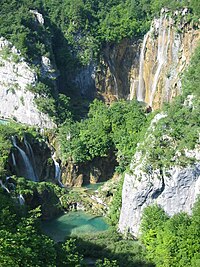
Photo from wikipedia
Abstract One of the major reasons for the increase in global air temperature since the early 20th century is considered to be the increase in the atmospheric CO 2 concentration.… Click to show full abstract
Abstract One of the major reasons for the increase in global air temperature since the early 20th century is considered to be the increase in the atmospheric CO 2 concentration. Karst relief is considered an important carbon sink, but it can also be a natural source of carbon and CO 2 emission. Aquatic systems in karst areas facilitate carbon exchange between the karst and the atmosphere, often through groundwater geochemical carbonate rock dissolution (carbon sink) and in the form of secondary calcium carbonate precipitation (possible carbon source). The protected area of Plitvice Lakes National Park, located in the karst region of Croatia, was chosen as a case study on karst geochemical processes. The lakes are also specific for their authigenic calcite precipitation in the form of tufa barriers and lake sediment. Physical and chemical data (temperature, pH, Ca 2+ , HCO 3 − , Mg 2+ and CO 2 concentrations, calcite saturation index ( SI calc ), calcite dissolution ionic ratio ( IR calc ), and Mg/Ca ratio) from water samples collected at 8 locations (2 springs, 2 rivers, and 4 lakes) from 1981 to 2014 were studied. The data were not collected systematically, so long-term changes have been mostly assessed through comparison between parameters from two selected periods (1981–1986 and 2010–2014) and through temporal correlations for each observed parameter in each calendar month. For the 33 years studied, an increase in air and water temperature, Ca 2+ and HCO 3 − concentrations, calcite saturation index ( SI calc ), calcite dissolution ionic ratio ( IR calc ), and a decrease in the Mg/Ca ratio were observed. No statistically significant change was observed for pH or CO 2 and Mg 2+ concentrations. Average discharge rates did not display any significant change over the past three decades, however there was a change in their seasonal distribution. The significant increase in Ca 2+ and HCO 3 − concentrations at lake locations were primarily caused by an increase in Ca 2+ and HCO 3 − values in the water of the springs. Simultaneously, Mg 2+ concentrations remained constant, which indicates higher levels of limestone (calcite) dissolution than dolomite dissolution. One of the reasons for this could be higher air/soil temperatures, resulting in higher soil CO 2 production, which appears to result in the higher dissolution of calcite exclusively. An increase in HCO 3 − concentrations at the springs implies that karst groundwater is a carbon sink. Furthermore, the fact that the spatial decrease in HCO 3 − concentration in downstream waters was the same during the 1981–1986 and 2010–2014 periods implies that the entire observed karst lake system itself is a carbon sink. Temporal and spatial changes in SI calc and IR calc values in surface waters were mainly attributed to an increase in the intensity of bioactivity, which is in turn connected with an increase in water temperature.
Journal Title: Applied Geochemistry
Year Published: 2017
Link to full text (if available)
Share on Social Media: Sign Up to like & get
recommendations!